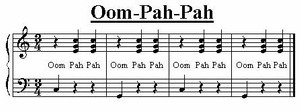Time Signatures
When you tap your feet to music, you are keeping time with the beat. You may notice that certain beats seem stronger than others. This strong beat is usually the first beat in a bar. Music is written in bars (this is nothing to do with creating a sore head) so that when reading, it is easier to group notes into phrases. Most western music has four beats to each bar.
A waltz which has three beats per bar is a good example of how bars sound with a strong first beat.
Strauss wrote many waltzes using the basses to play the first beat with french horns for example playing on the second and third beats creating the familiar Oom-
Time signatures consist of two numbers. The top number tells how many notes are in a bar and the bottom number tells what those notes are. If the time signature were 3 over 4 (as above), then this would mean each bar of music would have three crotchet beats. To find out the note value of a bottom number, the bottom number is related to the value of a semibreve. If the bottom number were 8, you divide a semibreve by eight so the beats in each bar will be quavers. There are four crotchets to a semibreve so if the bottom number were four then there would be crotchet beats in the bar. Similarly if the bottom number were two, because there are two minims to a semibreve then the beats in a bar would be minims.
Irregular Time Signatures
Irregular time signatures are so called because the amount of beats is unusual for example five or seven beats per bar. Irregular time signatures can have different length beats within the same bar for example, 7 over 8 could have three beats made up of two groups of two quavers followed by a group of 3 quavers. 5 over 4 typically has two beats per bar. Take Five, the saxophone tune by Paul Desmond of the Brubeck band has the two beats grouped in a three and a two to create a disjointed jazz waltz type feel.
There are two types of time signatures.
Simple time signatures
These time signatures have two parts to each beat for example 2 over 4 has two crotchet beats to each bar and these beats divide into half making two quavers per beat.
Some examples of simple time signatures,
2 3 4 5 7 2
4 2 8 4 4 2
Compound time signatures
These time signatures have three parts to each beat for example 6 over 8 has six quavers per bar. The quavers are grouped into three’s creating a waltz type feel to each beat. This time signature has two beats per bar.
Some examples of compound time signatures,
6 6 9 12 12
8 4 8 4 8
Compound time signatures can be easily recognised because the top number will be a multiple of three for example 6, 9, 12 etc. (not three!). As you can see from the two examples, the bottom number of a time signature does not affect whether the time is simple or compound.
In the grade-


